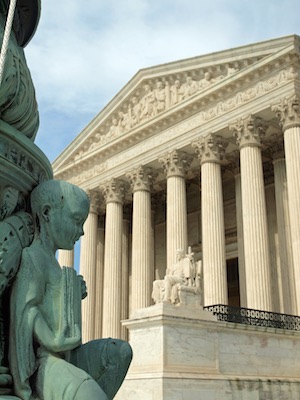 On Wednesday, March 22nd, the U.S. Supreme Court handed down a decision in a copyright case, which clarifies federal copyright law surrounding whether features incorporated into the design of a useful article are eligible for copyright protection. In a 6-2 decision, the Supreme Court held in Star Athletica, LLC v. Varsity Brands, Inc. that such features are eligible for copyright protection if they can be perceived as a work of art separate from the useful article and would qualify as an protectable work if imagined separately from the useful article.
On Wednesday, March 22nd, the U.S. Supreme Court handed down a decision in a copyright case, which clarifies federal copyright law surrounding whether features incorporated into the design of a useful article are eligible for copyright protection. In a 6-2 decision, the Supreme Court held in Star Athletica, LLC v. Varsity Brands, Inc. that such features are eligible for copyright protection if they can be perceived as a work of art separate from the useful article and would qualify as an protectable work if imagined separately from the useful article.
The case stems to a copyright infringement action filed by Varsity Brands against Star Athletica, charging Star with marketing cheerleading uniforms substantially similar to designs copyrighted by Varsity. Star argued that Varsity’s copyrights were invalid because the designs are for non-copyrightable useful articles and the pictorial, graphic or sculptural elements of Varsity’s designs were not physically or conceptually separable from the uniforms. The district court entered a summary judgment in favor of Star but this decision was vacated and remanded by the U.S. Court of Appeals for the Sixth Circuit in August 2015. The opinion handed down by the 6th Cir. entered a summary judgment victory in favor of Varsity, finding that the graphic features of Varsity’s designs are more like fabric designs than dress designs and are thus are protectable subject matter under the Copyright Act.
In January 2016, Star Athletica petitioned the Supreme Court for a writ of certiorari to appeal the case, reasoning that SCOTUS must grant an appeal to resolve the conflict between Circuit Courts resulting in 10 different separability tests and further arguing that the test developed by 6th Circuit was inferior to other tests.
In its decision, the Supreme Court determined that Varsity’s subject matter satisfied a two-step eligibility test: the surface decorations on the uniform can be identified as features having pictorial, graphic or sculptural qualities, and those decorations applied in a different medium would qualify as a two-dimensional work of art which didn’t replicate the uniform itself. The majority opinion, authored by Justice Clarence Thomas, applied reasoning from a 1954 Supreme Court case, Mazer v. Stein, in which the Court found that statuette bases for electric lamps were copyrightable even though the lamp itself was a utilitarian mass-produced item. A dissent authored by Justice Stephen Breyer, and to which Justice Anthony Kennedy joined, indicated that while much of the Court’s opinion was agreeable, “the designs cannot ‘be perceived as… two- or three-dimensional work[s] of art separate from the useful article.” Because the designs submitted by Varsity to the U.S. Copyright Office were “only pictures of cheerleader uniforms,” which are useful articles, and thus a picture of the relevant design features is simply a picture of the underlying useful article, whether the image is perceived separately or not.
What follows reaction to this newest Supreme Court copyright decision from a distinguished panel of industry experts.
 Kimberly A. Warshawsky
Kimberly A. Warshawsky
Partner, Ballard Spahr LLP
“The Supreme Court’s opinion provides much-needed clarity and simplicity on the issue of whether and under what circumstances designs on clothing can be copyrighted. Instead of the 9 various separability tests that the 6th Circuit noted and that other courts have used to determine whether a design can be copyrighted under Section 101, the Court set forth a simple test: the design can be copyrighted if it can be perceived as a 2 or 3 dimensional work that is pictoral, graphic or sculptural once it is separate from the useful article, provided the design meets of the other requirements for copyright (including originality). The “usefulness” inquiry no longer focuses on the item that is left (here, the cheerleading uniform) but instead on the usefulness of the design (here, the chevron stripes).
The Court did not decide whether the chevron stripes were themselves original and thus subject to copyright protection once removed from the cheerleading uniform. The Court also made it clear that the prior precedent holding that the design of clothing (neck lines, sleeves, skirt etc.) cannot be protected, because those are useful.
Following this ruling, I would expect that designers would start applying for copyrights because they are relatively inexpensive to obtain. The support for copyrighting designs remains to be seen, though, because there is a significant split in the fashion industry on whether it is wise to have IP protection for fashion given the fashion industry’s reliance on trends (which are spurred by copying at some level) and the speed at which the industry moves. Designers will also have to establish that the design is original such that it would be entitled to copyright protection at all.”
Kimberly A. Warshawsky is the Practice Leader of the Trademarks and Copyrights Groups, and a member of the Intellectual Property Litigation Group at Ballard Spahr. Ms. Warshawsky represents trademark and copyright owners for claims of infringement of federal and common-law trademarks and copyrights.
 Lauren Emerson
Lauren Emerson
Senior Association, Baker Botts, LLP
“Today’s decision has the capacity to impact not only those in the fashion industry, but also many businesses that employ design and decorative elements to sell products that might be deemed useful articles under the Copyright Act.
The majority opinion proffers a two-prong test for when a feature of a design of a useful article is copyrightable, and emphasizes that the focus of that analysis should be on those features in which copyright is claimed, rather than on “any aspects of the useful article that remain after the imaginary extraction.” In adopting this test, the Court rejects certain approaches previously advocated by others that focused on design process or marketability. While the decision answers some questions, it raises others, and I expect that courts will continue to struggle with separability analysis in the years to come,”
Lauren Emerson is an attorney with Baker Botts. Her practice focuses on trademark, trade dress, copyright, advertising, unfair competition and related issues. Ms. Emerson drafted the amicus brief to the Supreme Court in Star Athletica that was filed on behalf of the NYIPLA. She is co-chair of the NYIPLA copyright committee.
 Jeffrey Cadwell
Jeffrey Cadwell
Partner, Dorsey & Whitney
“The key takeaway is confirmation that designs featured on useful articles are protectable under copyright law if they can be perceived independently as a 2-D or 3-D work of art and if they otherwise would qualify for copyright protection. Accordingly, such copyright owners can prohibit reproduction of the designs not only on similar useful articles but also in any other medium of expression. The protection afforded under copyright does not extend, however, to preventing anyone from manufacturing the useful article without any of the design features present.
The Supreme Court today crystallized the appropriate test for protection by holding that “the design of a useful article is eligible for copyright protection only if the feature (1) can be perceived as a two- or three-dimensional work of art separate from the useful article, and (2) would qualify as a protectable pictorial, graphic, or sculptural work—either on its own or fixed in some other tangible medium of expression—if it were imagined separately from the useful article into which it is incorporated.” The Supreme Court rejected the oft-cited distinction between conceptual separability and physical separability, and instead said the language of the Copyright Act supports conceptual separability. This is because separability does not require the underlying useful article to remain.
The approach taken by the Supreme Court is consistent with both its past decision in Mazer v. Stein, which was decided under the 1909 Copyright Act, and with the language of the current Copyright Act, specifically Sections 101 and 113(a).”
Jeff Cadwell is a partner in the Minneapolis office of Dorsey & Whitney. He advises clients on the availability, registrability, and strength of proposed trademarks in both the U.S. and abroad, and assists clients with developing strategies for protecting and enforcing their trademark rights. He also counsels clients on copyright issues.
 Jed Wakefield
Jed Wakefield
Partner, Fenwick & West, LLP
“This opinion has major implications for the fashion and apparel industry. Over time, trends in apparel incorporate basic uses of colors, stripes, and other shapes that historically have been viewed as unprotectable aspects of the garments themselves. This decision calls that conventional wisdom into question. It injects uncertainty into the apparel industry, and will allow large apparel companies to leverage that uncertainty against low cost alternative providers, who often lack the resources to fight these cases.
Think of a classic rugby shirt: long sleeves, white collar, broad horizontal stripes. Can someone now claim that the creative choice of colors in their rugby stripes gives them a statutory monopoly—and a right to recover statutory damages and attorneys’ fees–against anyone who makes a “substantially similar” shirt? Of course, the defendant in such a case could challenge originality. But smaller companies often lack the resources to fight these cases, and many won’t. This threatens to decrease competition for basic styles that families want, and increases costs of basic garments that every family needs.
The case also has implications far beyond apparel, reaching any industry that involves designs of useful articles. Think of furniture and kitchen appliances. The potential arguments about whether even rudimentary designs can be identified separately from, and could exist independently of, the useful aspects of a protect are a potential hotbed for future litigation.”
Jedediah Wakefield is Chair of the Trademark Litigation practice group at Fenwick & West. He focuses his practice on intellectual property litigation, with an emphasis on trademark, copyright, trade secret and right of publicity matters, as well as licensing, technology transfers, and other complex commercial disputes.
 John DiMatteo
John DiMatteo
Partner, Holwell Shuster & Goldberg LLP
“Today’s decision is a big step forward for clothing designers. By finding that the design of a cheerleading uniform is separate from the uniform itself—even though when separated still looks like a uniform—is protectable under the Copyright Act, the Court greatly expanded an important intellectual property right. While it is too early to predict the consequences of the decision, we can expect clothing designers to file more copyright registrations and ask for higher prices to use their copyrighted designs, as well as additional lawsuits against parties that shamelessly copy those designs.”
John DiMatteo is a highly respected intellectual property litigator with experience handling patent, copyright, trademark and trade secret litigation before federal courts. As a registered patent attorney, he also handles Inter Partes Reviews (IPRs) and related complex U.S. Patent Office proceedings, and has represented clients before the International Trade Commission.
 Andrew Rapcke
Andrew Rapcke
Partner, The Rapacke Law Group
“This 6-2 Supreme Court decision affirming the Sixth Circuit’s reversal provides a mild win for some Industrial Designers by clarifying the proper test for evaluating whether an industrial design which incorporates artistic elements may be afforded copyright protections under 17 U. S. C. §101. The Court’s two-prong test for implementing §101 requires that the artistic feature “(1) can be perceived as a two- or three-dimensional work of art separate from the useful article and (2) would qualify as a protectable pictorial, graphic, or sculptural work—either on its own or fixed in some other tangible medium of expression—if it were imagined separately from the useful article into which it is incorporated.“ This clarity, however, comes at the cost of predictability. Although in this case, the Court held that the designs on the cheerleading uniforms were capable of being separated from the utilitarian garments on which they were printed despite their striking two-dimensional outline and resemblance to the underlying garments, it remains to be seen how other courts will apply this test to various forms of industrial design.
The Court made clear that the shape and underlying garment would not be afforded Copyright protections; however, the surface decorations may still pass this subjective test which requires that they can be separated in a manner that retains the artistic qualities while not resulting in a recreation of the underlying item. For designs that are developed to follow or mimic the shape of an item as the designs on the present case’s cheerleading uniforms did, this opinion offers hope that copyright protections may yet be available; still, this decision is far from a guarantee that others utilizing likewise gray-area designs will be as successful.”
Andrew Rapacke works with clients across a variety of industries. He assists individuals and corporations with protection, prosecution, licensing, and enforcement of intellectual property rights and has experience in patent, trademark, and copyright prosecution and litigation.
 David Leichtman
David Leichtman
Partner, Robins Kaplan LLP
“The Court sets forth a very clear and replicable test that a feature of the design of a useful article is eligible for copyright if, when identified and imagined apart from the useful article, it would qualify as a pictorial, graphic, or sculptural work either on its own or when fixed in some other tangible medium.
Footnote 1 also makes clear that the opinion, as in the Sixth Circuit opinion it affirms, does not address the separate originality requirement. Some of the amici had argued for a test that would have conflated those different inquiries. This is important to maintain the structural integrity of the validity analysis in litigation under the Copyright Act.”
David Leichtman is a Partner in the Intellectual Property Litigation and Business Litigation Groups of Robins Kaplan LLP. He founded the New York office of the firm in 2010 with two other partners. David has tried a variety of complex matters in federal and state courts including patent, copyright, trade secret and trademark cases.
 Jed Ferdinand
Jed Ferdinand
Senior Managing Partner, Ferdinand IP
“This is an important ruling for copyright law, in general, and fashion law, in particular. Today the Supreme Court held that a feature of a useful article is copyrightable if it can be perceived as a separately protectable work. In the cheerleader case, the Court specifically looked to the decorative two-dimensional elements on the uniforms and found them to be protectable. (See attached image) This would be akin to a fabric design, which has long been copyrightable. But, at the same time, the Court also made clear that the underlying cut and style of the uniform itself are not copyrightable. So the focus going forward for copyright purposes will be on the decorative design features of any garment, and not on the cut or style of the garment itself.”
Jed Ferdinand is founder and senior managing partner at Ferdinand IP. An accomplished trial attorney, with more than 20 years of experience, Ferdinand is an authority on intellectual property, licensing, media, entertainment and civil litigation.
 Donald Falk
Donald Falk
Partner, Mayer Brown
“The Supreme Court’s Star Athletica decision clarifies the dividing line between copyrightable art and useful but unprotected industrial designs. Copyright law may protect original designs that are incorporated into clothing or other useful items so long as the design could be viewed as a separate work of art, and if imagined separately would qualify for protection. Because the colored stripe, shape, and chevron patterns on the cheerleading uniforms at issue in the case could be reproduced in medium other than the uniforms, such as a painter’s canvas, they could be copyrighted. The key is whether the design could be replicated without also replicating the functionality of the article on which it appears. Although the Court issued three separate opinions, it unanimously agreed that designs of this kind could be copyrighted. In Justice Ginsburg’s view, the uniforms consisted of copyrighted designs that were reproduced on clothing; the designs were already separate from the useful article. Justices Breyer and Kennedy generally agreed with the majority’s analysis, but did not believe that the designs at issue were in fact separable from the uniforms.”
Donald Falk has an extensive appellate practice in which he presents oral arguments, briefs, and motions in the US Supreme Court, and many other federal and state appellate and trial courts. His work involves a wide range of constitutional, statutory, patent, securities, administrative, criminal and common law issues.

![[IPWatchdog Logo]](https://ipwatchdog.com/wp-content/themes/IPWatchdog%20-%202023/assets/images/temp/logo-small@2x.png)


![[Advertisement]](https://ipwatchdog.com/wp-content/uploads/2024/04/Patent-Litigation-Masters-2024-sidebar-early-bird-ends-Apr-21-last-chance-700x500-1.jpg)

![[Advertisement]](https://ipwatchdog.com/wp-content/uploads/2021/12/WEBINAR-336-x-280-px.png)
![[Advertisement]](https://ipwatchdog.com/wp-content/uploads/2021/12/2021-Patent-Practice-on-Demand-recorded-Feb-2021-336-x-280.jpg)
![[Advertisement]](https://ipwatchdog.com/wp-content/uploads/2021/12/Ad-4-The-Invent-Patent-System™.png)







Join the Discussion
No comments yet.